WALL-E is generally referred to as a children’s film, and I’m not going to argue: it’s an excellent children’s film—a classic, absolutely. I also happen to think that it’s an even better movie for adults, for whom its lessons are more poignant, possibly more resonant, and more necessary. Pixar has a knack for producing films which consistently operate on two different levels: one which speaks to a young audience without condescension or pandering, and one which reflects adult experience, rather than just exploiting nostalgia for idealized conceptions of childhood or simply spiking the cinematic punch with snarky, Grown-Ups Only pop culture references and in-jokes.
Movies like WALL-E and Up deftly evoke complicated emotional responses in adults in a way that most children’s films don’t, speaking to adults on their own level through smart, subtle storytelling that’s often amazingly, heartbreakingly simple. Consider the opening sequence of Up, for example, which has the power to make grown men break down and sob as if they’ve just been kicked in the heart, but doesn’t seem particularly traumatic for small children at the same time; it’s not that kids don’t “get it”—they just don’t necessarily react to the sequence in the same way that adults, carrying a little more emotional baggage into the theater, tend to respond.
WALL-E is Pixar’s most sustained and arguably most successful experiment in employing this radical narrative simplicity. For the first twenty minutes of the movie, there’s basically no spoken dialogue, only recorded human voices echoing around a long-abandoned Earth. During the making of the movie, the Pixar team studied and drew inspiration from silent films, particularly those of Chaplin and Buster Keaton, and the influence is palpable throughout the movie, but especially in these opening scenes.
The irony, of course, is that the era of the silent film greats was defined by the limits of available technology—these artists were driven to perfect a unique mode of expression because of the challenges they faced in the early days of cinema. WALL-E himself is literally a product of technology, the discarded creation of a society with no such limits, but also no vision, which eventually self-destructed in a downward spiral of mindless consumption and apathy. In WALL-E’s reality, there isn’t any dialogue because there’s no longer anyone to talk to, to talk with. Oddly enough, when we eventually get a glimpse of human existence later in the movie, there’s still no dialogue—plenty of noise, prerecorded messages, automated announcements, and verbal commands, but no conversation, and certainly no meaningful interactions between people.
WALL-E shares a kinship with Keaton and Chaplin that goes beyond his movements and mannerisms—in short, he is an artist. The opening scenes of the movie establish the fact that he possesses a remarkable capacity for aesthetic appreciation. His function, as a robot, is to clean up the planetful of garbage left behind by humanity—a mindless, thankless task, or it would be, if he wasn’t able to spend his days sorting through the rubble, collecting objects which appeal to his natural curiosity and sense of beauty. His prized possession, of course, is a beat-up VHS tape of Hello, Dolly! —his (and our) only link to a vibrant, thriving human past. In a sense, WALL-E is the last holdout of romanticism, stranded in an isolated industrial wasteland—and where Keats had a Grecian urn and Wordsworth had all sorts of abbeys and daffodils to inspire him, WALL-E’s experience of the sublime stems from a random 1969 Barbra Streisand musical…and that is genius.
I love that we’re never given any background on Hello, Dolly!, no belabored exposition on what it was and why we should care, no cute backstory about WALL-E finding his precious video cassette—all that matters is the feeling it evokes, within the context of the story. It’s such a fascinating choice for such a central plot device—a bloated, big-budget spectacle that was both one of the last great Hollywood musicals (directed by none other than the legendary Gene Kelley), and also a box office disappointment which helped usher in the end of an era, as cheery showtunes and sequins failed to impress late 60s audiences more interested in edgier fare. The movie version of Hello, Dolly! isn’t iconic enough to be instantly familiar to most audiences, but that fact makes it such a brilliant choice in a movie that urges you to look at the world differently, to appreciate the inherent value of creation and expression wherever you can find it.
Through WALL-E’s eyes, a campy Sixties musical suddenly becomes a lightning rod of varying emotions: joy, longing, passion…it brings WALL-E and EVE together, reunites them when they’re separated, and even serves as a call to action in a robot revolt in the second half of the movie. When the captain of the Axiom starliner views the recorded video of Earth stored in EVE’s memory, he’s initially discouraged—until the clip of “Put on Your Sunday Clothes” magically appears, steeling his resolve and inspiring him, finally, to return to Earth. The lesson is driven home again and again: singing, dancing, music, and art have the power to connect, to further our understanding of the world; art is how we communicate—it can inspire revolution, redemption, and change for the better.
More than anything else, WALL-E is a movie about the importance of appreciating and creating art—without it, we are cut off from each other, and from ourselves. As far as depictions of dystopian futures are concerned, the movie is rather gentle—nothing about the cushy Axiom is likely to traumatize small children… but at the same time, its indictment of a culture entirely devoted to the mindless consumption of “entertainment” with no artistic merit or intellectual value is chilling the more you think about it. And the movie really, really wants you to think about it.
When you get right down to it, WALL-E can be considered Pixar’s mission statement; it’s basically a gorgeous, animated manifesto. Over and over again, it drives home the point that civilization and self-expression go hand in hand—humanity is defined by its ability to move beyond mere survival into the realm of art: it’s no coincidence that, after meeting WALL-E, the captain’s crash course in the history of the world moves from learning about basics like “soil,” “earth,” and “sea” directly into “hoedown” and “dancing”: this is a natural progression, according to the movie’s logic. WALL-E spends 700 years on his own (Hal, his adorable cockroach friend notwithstanding), but as soon as he encounters EVE, he immediately attempts to reach out to her by building a sculpture in her image–that gesture alone betrays more passion and humanity than any of the any of the actual humans in the movie are capable of mustering, until the very end. And this is why I think adults may have more to learn from WALL-E than kids do….
George Carlin famously said, “Scratch any cynic and you’ll find a disappointed idealist.” For me, more than anything else, WALL-E is a movie that speaks directly to the cynics, the apathetic, and to anyone who has lost touch with the fundamental urge toward creativity and expression, with the sheer joy and heights of emotion that art can bring. Just watching the closing credits is inspiring, as they move through the style of cave drawings, Greek and Roman art, Seurat, Van Gogh, all the way up through 8-bit video game-style graphics. It drives home the message that the world is full of inspiration, sometimes where we least expect to find it. It’s clear that the folks at Pixar see themselves as participating in this grand tradition that includes everything from ancient graffiti to Renaissance masterpieces to Modern Times, and 2001, and even Hello, Dolly! Every aspect of this movie is imbued with the power of its creators’ convictions: WALL-E is Pixar’s luminous love letter to the creative process…one which will hopefully continue to inspire adults and children alike for many years to come.
Originally published in June 2012.
Bridget McGovern is the non-fiction editor of Tor.com. She is making it her mission in life to mount an all-robot production of Mame, just as soon as she finishes building her Bea Arthur-bot. You can follow her on Twitter.










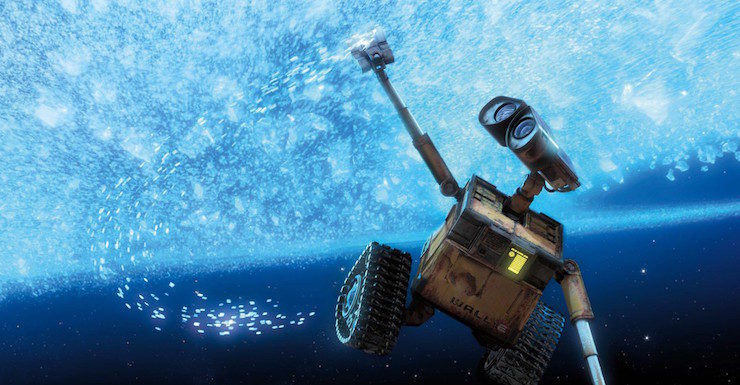
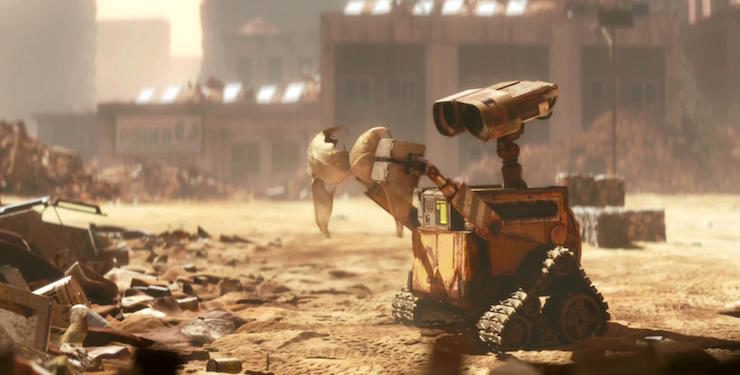
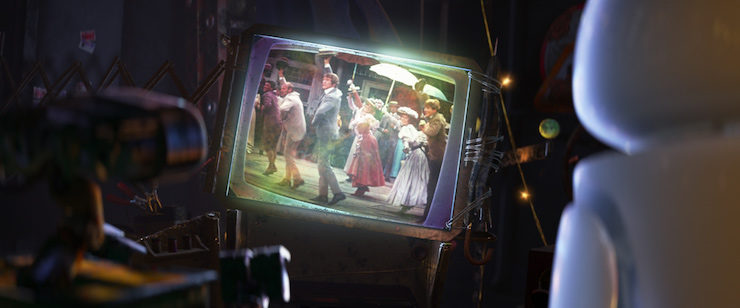
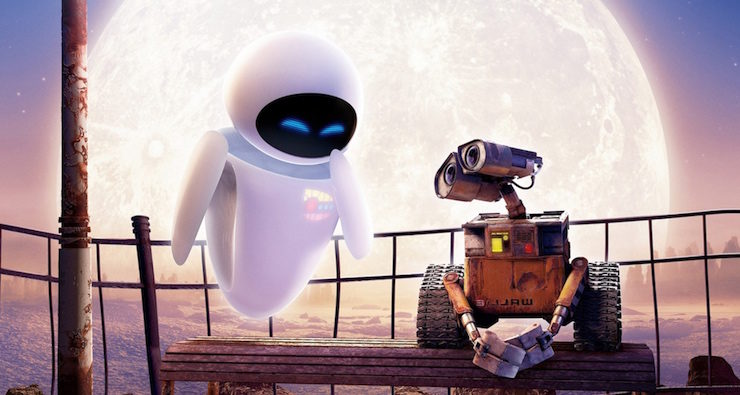
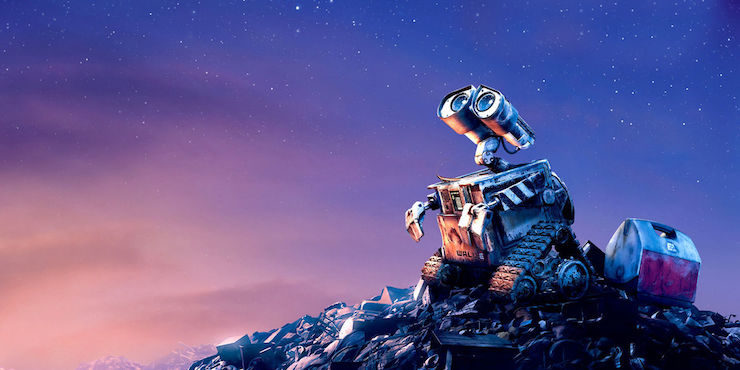
WALL-E’s visual artistry extends to some of the most grotesque, vulgar and classist examples of body-shaming and abjection that should be deservedly critiqued in any form of entertainment especially for children.The ship of fat, bad humans who at the end credits sequence visually signify woke equals slender and desirable is as viscerally disgusting for many fans as anything jingoistic by Heinlen.
The film can’t be discussed without including this particularly brutal display-in this case I unabashedly agree that the film is a testament to power of art, since it took years for animators to draw such lovingly rendered monsters whose moral lassitude is worn right on their bodies. Hopefully in the film’s next decade, these hateful images can be called what they are. If you’re committed to engaging with problematic issues, this must be included and not just breezed over —these images are patently offensive and should make this at the very best a problematic favorite—certainly not one deserving of blind adulation.
@1 At any point in the movie is it mentioned that their bodies are a problem? do they mention that being as they are is a bad thing? are they shown to be less capable? I don’t believe so, the reason they can’t move well at the beginning is because they’ve been sitting down their whole lives, muscles atrophy like that. Also, the point is Auto wanted people to be lazy and people allowed it.
I believe it is only hateful if YOU make it so, the movie doesn’t. Exercising and working on the fields improve the body, that’s just biology, again it is never shown or implied if it’s better or worse, the fact that you consider it that way talks more about your personal experiences that what the movie is conveying.
Best regards.
I agree with #2 Angel. It’s one thing to point out mistakes others made, but if they used classic and recognizable art styles for the end credits, they might have felt bound by the precepts those styles represented. My wife and I are both working on our accumulated extra by hitting the gym, but neither of us have ever felt “shamed” by the movie.
I saw a comic the other day where one character accused another of reading a post about how “Thomas the Tank Engine” was intended as representing a socialist dystopia. Sometimes people can work too hard to read into things.
… and fatphobia gets okayed with more fatphobia. The bodies are coded as ugly and undesirable, conflated with the garbage on the planet. A cockroach gets more humanity in this film than the humans—and “just biology” has been used to justify all kinds of hideous “true” portrayals of other people. Having it in a film made by a studio with hipster nerd cred doesn’t make it acceptable. If we can interrogate writers like Lovecraft, don’t we owe it to call out hateful imagery , especially if it’s something near and dear?
Cheers.
What exactly “codes” the bodies as ugly and undesirable? The captain, the man and woman who look up from their screens and notice each other in real life, all of them act courageously and with humanity and love. Is it just you who thinks they look hideous? I certainly don’t.
@@.-@ well i wrote a big comment that for some reason didn’t get posted. So I’ll try again but shorter. My main point is separating in-world from out-world. The characters in-world don’t find each other ugly or they wouldn’t find each other attractive, nobody gets judged, and if they can’t move properly at first it’s because they haven’t used the muscles much (think The Matrix) and because an “evil robot” doesn’t want them to.
Out-world we can choose to judge them as normal, fat, ugly, or whatever, and i view it as “if they don’t judge each other, I won’t”. A lot of SFF books (at least the ones I’ve read) present varied characters, with different characteristics, customs, and looks, and nobody thinks wrong cos in-world they are just normal. I believe we out-world are the ones that decide to make it hateful, or just different, or in this case normal.
Finally, the “just biology” is because: if you work and exercise then you get fit, that’s how the world works and I’m just stating nature, again I never said it is better or worse, just cause and consequence. (I don’t really remember the credits, I was assuming by your comment that they get thinner when they work the land, if I was wrong they I apologize).
@5 exactly
@1, 4 StoneTelling, I don’t know if you’re just trolling or are legitimately outraged by this movie, but, either way, please try to at least engage in an actual discussion rather than baseless accusations.
First, the movie makes it pretty clear that the humans aren’t actually bad – AUTO is (sort of). Furthermore, what the movie does show is that 1) living in space for generations is unhealthy and 2) eating junk food non-stop and never engaging in physical activity is also unhealthy. Acknowledging these things is not fat shaming; it is fact and encourages audiences to think about their choices and live healthier.
@5, 6 I guess you already beat me to this while I was writing, but I guess more voices of reason never hurt.
I can say with certainty that 100% of viewers need not think about their choices to live in space for generations.
Don’t wreck the planet and people won’t have to live in space for generations. Those are the choices.
IMHO, I have to say I agree (as a larger person) with StoneTelling to some extent here. Yes, the film makes it clear that the humans are unhealthy because of their limited life on AUTO, which is not a good thing. However, the film also presents images of larger people as negative. Yes, there is context here; in general, being mostly non-active and eating junk food all the time is not the greatest idea (I say “in general” because I don’t mean to degrade anyone who, for whatever reason, doesn’t have the choice to not do so).
One of the main points of the article is the way in which adults and children experience these movies differently. Adults see more nuances. A child who may be overweight (for whatever reason) may see these people on the spacecraft and feel bad about themselves.
I also DO reject the idea that anyone, adult or child, who is heavier than the “ideal” person is somehow unhealthy. I know Tor isn’t a forum for political commentary, but I’ve seen a lot more of “fat-phobia” in recent years (I am a U.S.ian), including claims that people who are heavier than the arbitrary standard are somehow “costing” other people in the U.S. too much money. I am probably heavier than I should be, but I am also overall healthy (my many doctors agree). Anything I’m “costing” taxpayers has to do with my congenital blood-clotting problems, NOT my weight.
I fully support healthy living and promoting healthy lifestyles. However, people naturally have different body types. And I can understand how children might feel upsetted about the depictions of the “larger” humans in this film. I know this is anecdotal, but one of the reasons I loved “Snow White” as a very young child (actually, I was probably TOO young to be watching that movie) and then kind of fell in love with Belle from “Beauty and the Beast” was because they both HAD DARK HAIR. (I have dark brown hair naturally and I dye it black.) It was and is important to me to see myself represented on the screen. Representation is essential. I used to be a lot skinnier (one of the medications I used to take caused me to gain a LOT of weight, which I am still trying to lose). So now I am still trying to look for positive representations of HEALTHY people who look like me. That is one of the reasons why I really enjoy “My Crazy Ex-Girlfriend:” the main character played by Rachel Bloom is not exactly skinny. And her best friend Paula played by Donna Lynne Champlin is even heavier than the main character. But they both are written as attractive and desirable.
I think there is a lot of politics and classism (and heck, maybe even racism for that matter) behind the current fat-phobia. I will never deny that being healthy (no matter what your weight) is a good thing and that more media outlets need to promote healthy eating and living. BUT…presenting a universal, often unattainable, body type is disturbing, at best.
I just rewatched the end credits, and I don’t see the people of the Axiom suddenly getting all buff just because they’re out working hard to grow food and rebuild the world. For what is probably many generations you still see people whose arms and legs have grown strong but are not thin. Not until the end of the history, after city buildings have been turned into a town and there are graceful boats on the water, and clearly a good sized area of the planet has been made green again, do you see someone sitting on a bank fishing who looks thinner. Since the last thing we see is the massive oak tree grown from the seedling in the boot, a few centuries have likely passed. This branch of the human race (because somewhere out there may be more ships; this one was just the luxury liner for the rich elite) accomplished everything from literal step one, learning to walk on their own two feet, to reclaiming Earth, and if their artwork recording those times shows them still not going back to what is considered normal in the images recorded of humans these days (more advertising than fine art, admittedly), then that’s probably still the norm for the descendants of the Axiom humans.
I never noticed that the seedling grew into an oak. It looked plainly like a bean seedling to me!
@12: Yes, you see Wall-E and Eve under a huge tree at the end, and then it pans down to show underground, among the roots, the old boot.
One of my friends who is pretty vocal about body politics etc also was upset about this movie when it first came out. The issue is perhaps the visual shorthand. It’s true that a life of non-movement and mindlesss consumption will basically result in out of shape bodies as we see in the movie. But the converse is not necessarily true – even amongst healthy/active people there are a wide range of body types. So I think there is a fear that this is just reinforcing that stereotype since it is true people tend to subconsciously view larger people as less intelligent, less moral, etc. I can’t say it personally bothered me, but I can see why it would for others.
But other than that, it is a movie I enjoyed – especially the first 20 minutes. I wonder how much of the movie they could have gotten away with being dialogue free.